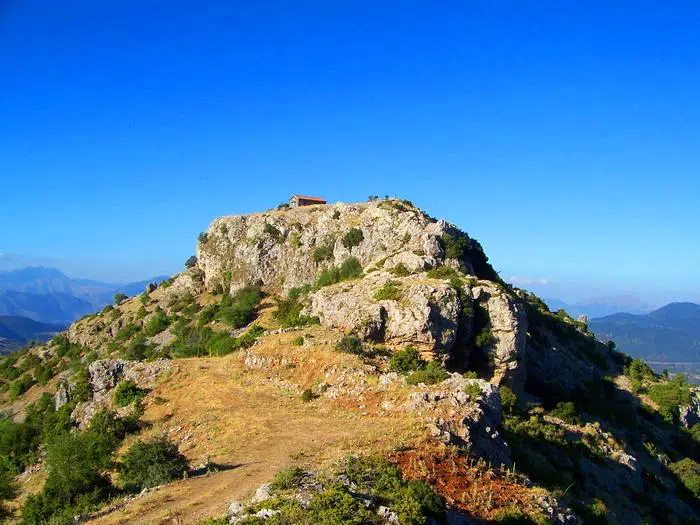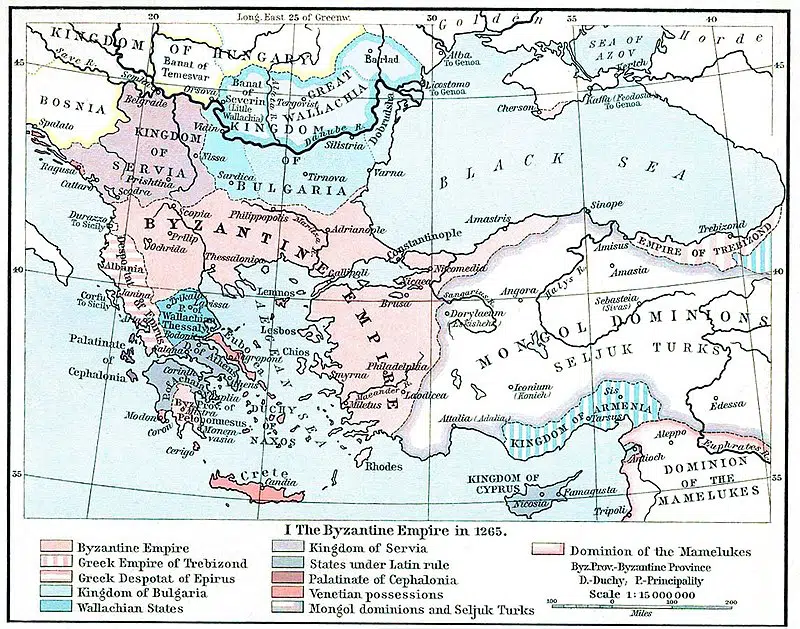
The Chronicle of the Morea (Greek: Τὸ χρονικὸν τοῦ Μορέως) is the history of 14th-century Greece, specifically the Peloponnese—once called the Morea—through the eyes of the Franks who ruled it at the time.
More than 9,000 lines long, the Chronicle narrates events of the Franks’ establishment of feudalism in mainland Greece after the conquest of Constantinople in 1204 following the Fourth Crusade.
The Chronicle of Morea is the key source for the history of the Frankish states established in Greece after the conquest of Constantinople in 1204 and their relations with the reviving Byzantine Empire during the 13th century.
“Fair Morea” was taken by Frankish knights returning from Fourth Crusade
West European Crusaders settled in the Peloponnese (called Morea at the time) following the Fourth Crusade, in which Constantinople was sacked and taken. The period covered in the Chronicle was 1204 to 1292 (or later, depending on the version), and it contains invaluable details regarding life in the Principality of Achaia during the medieval period.
The author of the original text of the chronicle appears to be a Franc or a gasmoule (a French-Greek man), born from a mixed marriage between the two peoples. He appeared to admire the Franks (Crusaders) and have contempt for the local population and the Roman Empire. However, the author respects the citizenship of the Byzantine Greeks, calling them Romans (Ρωμαῖοι).
In any event, his narrative forms an important part of Western history on Greece at the time, coloring the way Westerners saw the country for centuries.
A 1964 translation of the Greek text by Harold E. Lurier begins with a prologue of 1302 verses. The first three verses are:
“I will a tale to thee rehearse, a tale of import mighty,
And if attention you do lend, I hope the tale will please you:
Tis how the Frank by arms did gain the realm of fair Morea.”
Despite being written down in the thirteenth century, the Chronicle of the Morea, along with the Ptochoprodromic poems and acritic songs, is considered as the beginnings of modern Greek literature. It is classified as part of both “Byzantine / medieval vernacular” and “(early) modern Greek” literature.
Written in the spoken Greek language of the time, the Chronicle is an invaluable window into a world that is long-gone, but whose remnants we can still see today atop the hills of the Peloponnese, and in Achaia in particular. The Villehardouin knights who had fought in the Fourth Crusade, and sacked Constantinople, were prominent among the French noblemen who came to rule the area.

Chronicle of Morea is important linguistic text showing development of the Greek language
The French text that is now in Brussels was written between 1331 and 1346 and is believed to be an abridgement of an earlier text, since the person who copied it states that he was transcribing parts of the Chronicle from an exemplar that belonged to Bartolommeo Ghisi, a castellan who lived near Thebes in the early fourteenth century.
The text begins with a chronology that records the major events in the Byzantine world with a focus on the Peloponnese. Initial entries record the sack of Jerusalem by the armies of the First Crusade in 1099, and the last describes the conquest of several Frankish castles by Byzantine forces under Andronicus Asen in 1333.
The narrator relates battles that took place during the Fourth Crusade, including the capture of Constantinople and the subsequent takeover of the Peloponnese (then called Achaia or Morea) by Frankish knights under William of Champlitte.
His compatriot, the French knight Geoffrey of Villehardouin, the nephew of the famous chronicler of the taking of Constantinople, established a principality in the Achaia region.
The Villehardouins resided in castles for generations; remains of one of his summer homes are seen in the photo above.
The author pays particular attention to the establishment of the fiefs of the conquerors; following his narrative of the battles, he records names of each fief-holder in the newly-created Principality of Morea.
Details of Byzantine and feudal life and arranged marriages all part of the Chronicle
The Chronicle includes an epic recounting of the battle of Pelagonia in 1259, focusing on the heroic deeds of several French knights in spite of their eventual defeat by the Byzantine Army.
Preserved in a unique fourteenth-century manuscript, the Old French version of the Chronicle of Morea is an invaluable contemporary account of Frankish feudal life. It serves not only as a history of the military clashes and conquests between the Franks and Byzantines; it includes background on their alliances and their arranged marriages as well.
A rich historical treasure, written by an eyewitness to the turbulent events of the time, the Chronicle of Morea is full of anecdotes providing invaluable insights into the world of feudal justice and warfare, the role of noblewomen in feudal society, and the importance of chivalric ideals.
Although the original has tragically been lost in the sands of time, four versions of the Chronicle are still extant: in French, Greek (in verse), Italian, and Aragonese; experts remain uncertain as to which version was the original, though it is known that the purported author was of French and Greek descent.
The verses of the Greek text are written in the form of a 15-syllable political verse and, perhaps most remarkably, in the spoken Greek of the time with the inclusion of several French words.
Two parallel Greek texts exist, as well as three copies: the Havniensis 57 manuscript from the 14th–15th century is in a library in Copenhagen; the Taurinensis B.II.I manuscript of the Chronicle is at the library in Turin; the Parisinus graecus manuscript, from the 15th–16th century, is in the holdings of the Bibliothèque Nationale de France in Paris.
The oldest text, in Copenhagen, contains more archaic language, while the Parisian, written approximately one hundred years afterward, has simpler language and fewer foreign words. Several anti-Greek references were omitted in the transcription, so the overall text expressed less contempt for the Greek people.

Changes that took place between versions show development of Greek language
The changes that took place over the passage of one century between the Copenhagen and Parisian version of the story shows considerable linguistic variation over time due to the rapid evolution of the Greek language. The text of the Copenhagen version describes events that occurred in the Morea up to the year 1292.
The French-language text, housed in the Royal Library of Belgium, is entitled: “The Book of the Conquest of Constantinople and the Empire of Roumania and the Country of the Principality of Morea.”
Events up to the year 1304 are recorded in this particular version of the Chronicle.
However, the much later Aragonese version of the Chronicle, “Libro de los fechos et conquistas del principado de la Morea,” was compiled at the end of the 14th century, in 1393, from the Greek version and other later sources at the request of the Grand Master Jean Fernandez de Heredia of the Knights of St. John. It covers events up until the end of that year, bringing those times well into the Middle Ages.
The great historical significance of the Chronicle
The Chronicle is well known and is an invaluable historical document, in spite of some undeniable historical inaccuracies, because of its lively description of life in the feudal community and because of the character of its language, which reflects the rapid transition from Medieval to Modern Greek.
A number of administrative laws, political, and social practices of the Principality of Achaia are mentioned in the Chronicle, making it a significant source on the Frankish period in Greece.
Since the author admired the Franks and apparently had contempt for the Byzantine culture, the Chronicle of Morea did not become part of popular or academic culture in Greece after the Franks left the Peloponnese.
The first printed edition of the Chronicle, containing the Greek text from Paris, was published in 1840 by J.A. Buchon. It continues to serve as one of the great voices from that faraway time since it was written by the men who lived through these battles and created a feudal realm that lasted for centuries in what was to become modern Greece.
See all the latest news from Greece and the world at Greekreporter.com. Contact our newsroom to report an update or send your story, photos and videos. Follow GR on Google News and subscribe here to our daily email!



